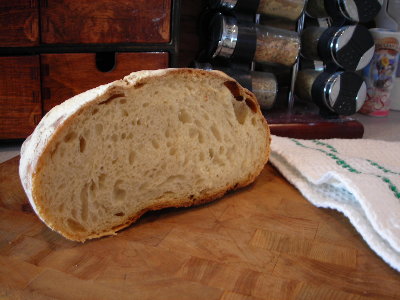Monday, December 15, 2008
| 鮮蝦蒸蛋 壹蘋果美食diy食譜 材料:蛋3顆、雞高湯130c.c.、蝦仁10尾、薑片2片、蔥花1大匙、米酒1大匙 | ||||||||
將雞高湯混合雞蛋,先打勻後,再將其倒入濾網過篩至碗公內。 | ||||||||
將做法1蓋上盤子或包覆保鮮膜後,再用大火蒸約10分鐘。 | ||||||||
取一平底鍋,放薑片爆香;放蝦仁、米酒煮收汁,灑蔥花,倒在做法2上即可。 | ||||||||
材料:排骨2斤、蔥2支、老薑1條 調味料:紹興酒1大匙、鎮江醋2大匙、砂糖3大匙、醬油4大匙、水5大匙 準備:排骨切塊汆燙去血水、蔥切段、薑切片。 Tips:用1瓢酒、2瓢醋、3瓢糖、4瓢醬油、5瓢水,搭配2斤排骨,故稱12345滷排骨。 | ||||||||
取一大碗,加入紹興酒、鎮江醋、砂糖、醬油和水攪拌均勻。 |
Friday, December 12, 2008
太龜毛反而失準頭,談「亂下決定」的絕妙心法
by Mr. 6 on December 12th, 2008, 目前有 13 則留言, View blog reactions
明天要去哪裡玩?
應接受哪一份工作?
該和哪一個對象結婚?
昨天看到RedOrbit一則有趣的新聞報導,引用最新一期《Psychological Science》來自杜克大學的研究,研究人們有時會碰到「難以決定的事」。小的可小至今晚該在哪裡吃飯,大的可大到該不該和「這個男的」分手。科學家做了一輪實驗後,竟然引導出一個驚人的「決定心法」──
那就是,當你碰到一個很複雜的問題,與其慢慢去想遍了所有可能性,一一分析思考甚至問人,不如就完全不要想、不要問,不要求籤也不要沉澱,在當下就直接請自己「潛意識」,當場幫你做一個決定。
這個決定,科學家發現,往往是異常的「正確」!
譬如,到異國自助旅行,好多地方想去玩,沒時間塞這麼多行程。我們僅有的這一整天,應該選哪幾個地方?先去商場逛街嗎,還是先去名勝古蹟,要搭公車 加地鐵,還是多花點錢坐出租車?該不該買門票去某樂園半天,中午該選哪家餐廳?雖然旅行本身是有趣,不過做這種決定還真是痛苦的,但卻又一定得作某個決 定,因為再過一小時就要出門了!怎麼辦?科學家建議的就是,別再去抽絲剝繭的分析哪一個行程最棒了,直接就「通通放掉」,「隨便選一個」,用直覺直接下決定。
杜克大學研究人員找來好多位實驗者,將他們分為A、B、C三組,要他們考慮周全後,在精心安排的四個「差不多」的選項中選擇一個。科學家要求A組得 某個時間內答出來(譬如三分鐘),B組則被允許想多久都沒關係,想完再慢慢告訴答案即可,C組和A組類似,只給一段時間思考,但是在時間快到時,科學家會 給他們一大堆干擾,強迫他們分心,逼他們沒辦法限時內想完,就得靠「潛意識」趕快隨便給出一個答案。
驚人的結果出現了:
隨便猜猜的C組,竟然表現的比專心思考的A組還好,在四個選項中做了正確的選擇,而且其正確度已經接近了B組的水準。也就是說,同樣是被限時間內要答出來,專心想的,竟比「隨便想」的還差!也就是說,靠潛意識所做出的答案,比清楚意識還要強?
科學家的解釋如下。他們說,一般人碰到複雜問題,總會想辦法將「所有可能性、所有道理」都在腦中列出來,在紙上寫下來,不過,人腦的運算力量顯然遠比我們想像強大,在開始計算之後沒多久,其實已經「感覺」到最好的選項是哪一個,這時候,若不馬上跟著感覺走,還要硬就往深度挖下去,人腦就會開始被一些「不重要的資訊」給影響到。
科學家說,思考的時間愈多,許多注意力就開始從重點被分散到其他較不重要的地方,想了老半天,想到最後一分鐘,直到當事人發現時間不夠,為了要在時間內完成,就拿著剛剛整理的五花八門的思緒,做出一個「錯的決定」。
不過,顯然「潛意識」也要小心使用,科學家另外設計了第二份考題,讓四個選項變得差異很大,只要稍微想一下,就可以區分出那個最正確的選擇,科學家發現,這樣的考題,對於C組就不行了,A組比較厲害。也就是說,剛剛這種「潛意識」,只能放在選項差不多、無法解的狀況下,我們人類不能什麼決定都用「潛意識」,只有在難以決定的「兩難」、「三難」、「四難」的習題時,才適合呼喚你的潛意識!
有趣的是,同一期《Psychological Science》學術期刊,剛好也有另一篇相關的研究同時刊出,它也是關於「決策」的。他們說,當你無法決策時,除了「潛意識」,還可以用一種方法來加強正確度,那就是帶著「權威感」(power)去下決定。
科學家找來一些實驗者,將他們分為A、B二組,A組讓他們回想一下老闆或上司或老師很有權威的欺壓他們的樣子,意圖讓A組人感覺到很軟弱 (powerless),而B組則請他們回想他們當領導人或得獎的回憶,讓他們覺得自己很是強悍(powerful)。這時候,再丟給他們一個問題,在4 輛車之中選一輛最棒的,四輛車各有12項內容,相差不遠,難以選擇。然後科學家還刻意在兩組中選出幾個人,讓他們分心,試圖造成剛剛第一個實驗的「潛意 識」效果(兩個實驗似乎來自不同的實驗室,顯然這兩個實驗室有彼此在聯絡)。
結果科學家發現,A組的人因為軟弱,常常做錯決定,而B組的人因為強悍,做的決定往往比較正確!有趣的是,當科學家強迫他們要用潛意識來直覺判斷,A組就可以做到和B組一樣的水準。而B組無論是不是在潛意識,強悍的他們,都可以準確的做出正確的決定!
兩個實驗,得來的結論之一,就是:
決定時,最大的問題是在「把不重要的看成重要的」。這個問題已經很難了,還要再丟個問題給自己,哪個重要哪個不重要;看起來很小心的人,其實做出的盡是錯誤決定。
我不禁想到從前的我。
好久以前,在美國與朋友有一場對話。也不怕大家笑,由於高中大多時候關在家,我對人際是非常慢懂的,一直到研究所才開始與同學出去玩、吃飯。我當時 和這位朋友討論我在學生時代,每次要輪到我選餐廳(我們都會輪流選),我都說,「唉,算了,讓其他人選吧!」或是當我選了一間日本料理,另一人突然說 「咦,有間泰國菜也不錯!」,我就馬上改口:「好,就你說的,泰國菜!」
這位朋友說,我怎麼都不下決定啊?
有一次,我們一群人為了做學校專案,十幾個人站在那邊爭執,不知道該怎麼辦,有一個平常很安靜的組員,突然看不過去,就衝出來揮揮手,「哎呀,別鬧了。」他說。
「我看,就這樣處理。」這傢伙比手畫腳的,「你呢,這樣;他呢,就那樣。」
旁邊其他人默然不語的聽著他的指示。我覺得很神奇的是,大家都附和:「好啊,好啊!」雖然我心裡一邊幫某甲捏冷汗,一邊也抱著看好戲的心態,「既然 決定了,那你某甲要負責啊。哈哈,等著看好戲。」我想,很多人的心情都是這樣。就是因為知道這樣的心情,反而更不敢下決定,也更在群眾中站不出來。
才終於知道,我們不敢下決定,往往是因為懼怕「下錯了決定」。下了決定就要負責,萬一找錯了地方,那就不知怎麼 對大家交待。如果是和朋友一起,那就把決定權推給朋友,但如果是「自己的事」,就不能問其他人了!就要自己想辦法決定。這時候簡直是很大的痛苦,因為我真 的很怕自己做錯決定!所以我把每一片磚塊都掀起來看看,把每一包盒子都打開來看看,把每一片垃圾紙屑都撿起來以免遺漏了什麼……但最後是更多的雜亂資訊, 萬一哪一道資訊剛好打中我腦中的偏頗價值觀,我可能會突然間選了這條!譬如昨天講到「校園比較網」,選校園,想了半天,竟可能因為某家校園旁邊有間好吃的 餐館就選它,結果還沒開始上課,那間店就先倒了!這種錯誤至極的決定。
後來我成長了,因為人生的過程中,實在有太多決定要下了。當我愈飛愈高,決定就愈下愈多;在學生時代。我們可以不下決定,但不可能到其他地方也是這樣。我們成長後,這時候我們才一窺「下決定」的真相。
真相就是:「下決定」,其實不是最後一步!
幹嘛這麼緊張。
下決定,其實是「第一步」。下了決定後,接下來的事情才會慢慢展開,這時候,你有很多的時間來改變它。尤其當我們是決定者,既然要「負責」它,大家就跟著我們走,接下來自然就有了權力和說服力來安排接下來的事。就算這個決定可能很爛,但有可能在決定之後的這些過程中,我們把它扭轉回來了。
選了一間很難吃的餐館,但我們找到一個很好的座位,吃飯的時候氣氛很好,還隨興請大家喝了一杯果汁,飯後還可以突發其想到旁邊一間奶茶店喝杯不一樣的。
學會了「下決定」是「第一步」,為了快快開始,我很快就下了決定。這個時候我有「權威感」,我也是用「潛意識」,以科學家的實驗來看,這樣情況下所下的決定,至少不會是個差的決定,再加上決定之後的努力,我們可以變成一個「很會決定」的人。決定也是一個很強的競爭優勢!
Saturday, December 06, 2008
Ultimate Nachos
- Prep Time:
- 20 min
- Inactive Prep Time:
- hr min
- Cook Time:
- 7 min
- Level:
- Easy
- Serves:
- 80 nachos; about 6 servings

3 to 4 jalapenos, thinly sliced*
4 1/2 ounces diced red onion, approximately 1 cup
6 ounces finely grated Cheddar, approximately 2 1/4 cups
6 ounces finely grated Oaxaca cheese, approximately 2 1/4 cups
2 tablespoons finely chopped fresh oregano leaves
2 cups fresh salsa
2 cups sour cream
2 cups guacamole
*Cook's Note: Depending on your heat preference, you may remove the seeds from the jalapenos or leave them intact.
Set 1 of the oven racks on the lowest shelf and preheat oven to 350 degrees F.
Line a baking pan with parchment paper. Make 8 (2-inch) balls out of aluminum foil. Spray 3 wire cooling racks with non-stick cooking spray and place 1 of the aluminum balls in each of the corners of 2 of the racks.
Lay 1/3 of the chips on one of the racks. Top each chip with a jalapeno slice and sprinkle the chips with 1/3 of the red onions, and 1/3 of both the Cheddar and Oaxaca cheeses. Repeat with the remaining chips and the other 2 racks. Stack the racks on top of one another and set into the parchment lined baking pan. Bake in the oven on the bottom rack for 7 minutes or until the cheese begins to bubble. Sprinkle with fresh oregano. Serve immediately with the salsa, sour cream, and guacamole.
來賓 | 張麗蓉老師 | 莊寶華老師 |
菜名 | 芝麻燒餅 | 蔥燒餅 |
材料 | 材料: 作法:
| 材料: 作法:
|
來賓 | 蔡萬利老師 | 亨利廚房廚藝總監─郭宗坤 |
菜名 | 味噌拉麵 | 月見拉麵 |
材料 | 材料: 作法:
| 材料: 作法:
|
Friday, November 28, 2008
材料:
細麵 二兩/75克
麻醬 兩茶匙
雞湯 三大匙(或三大匙熱水加1/4茶匙雞粉)
醬油 一大匙
黑醋 一茶匙
紅油+辣椒渣 一大匙 (中辣)
花椒粉 少許
蔥花 少許
做法:
一. 開水煮麵 (水裡加一點鹽)
二. 麻醬用雞湯稀釋調勻,加入醬油,黑醋,紅油
三. 麵煮好倒入調醬的碗中,撒上花椒粉與蔥花,拌勻即可食
註一.可另加蒜泥,花生粉,榨菜,或炒肉末,但有基本的調料就很好吃了。
註二.捨麻醬多加一匙醋是酸辣麵,捨麻醬加一小匙蒜泥與砂糖是紅油燃麵。
四川泡菜
周老師的美食教室把這道菜的做法介紹的好極了!
獨門紅油
材料:
辣椒粉 三大匙
匈牙利紅椒粉(paprika) 一大匙
鹽 一小匙
大蒜 兩顆拍碎
植物油 一碗
做法
一. 把辣椒粉,紅椒粉,鹽拌勻置於碗中 (紅椒粉微帶煙燻味,不辣,調入油中可提升色澤的紅艷度)
二. 中火熱油,大蒜倒入炸到香即關火,靜置降溫五分鐘
三. 撿出大蒜,溫油倒入辣椒粉碗中稍稍攪拌,靜置數小時可入味
Thursday, November 27, 2008


This recipe first appeared in the New York Times in November 2006. Mark Bittman visited the Sullivan Street Bakery where Jim Lahey, who devised this tasty bread and its unique cooking method, demonstrated how to make this bread.
This was one of the most emailed articles from the New York Times, because its simple and results in a magnificant loaf of bread.
Unlike most recipes that have you hunting in speciality stores for ingredients you will never use again, this recipe has four basic ingredients: Flour, water, salt and yeast. No sugar or added fats. And it's inexpensive - one standard package of yeast will make about 6 loaves of bread! I estimate ingredients for this bread cost about 50 cents - you would pay $3.00 to $4.00 for this loaf in an artisan bakery! Plus, there is NO KNEADING! None! Time does all the work in creating the gluten that gives bread its unique structure.
Time and patience are the key elements to making this recipe work. The bread needs 19-24 hours to work its magic prior to baking.
The following is a visual guide to making this delicious bread, based on much experimination with various techniques and tools.

3 cups all purpose flour or bread flour
1 1/2 - 2 1/2 teaspoons salt (depends on your taste)
1/4 teaspoon instant yeast
Mix well to combine dry ingredients
Add:
1 1/2 cups water
Cover your dough (it will not be very pretty) with plastic wrap and place in a warm place (at least 70 degrees). I find the microwave oven (off, of course) makes an excellent resting place. I usually make this in the evening so I can bake bread the next evening. In some ways, this is easier than conventional bread baking where everything happens in compressed time - you end up baking until 11 at night. With this method, this first step takes just five minutes.
Now, let the dough rest in the paper from 1-2 hours, or until about doubled in size. I usually do this out on the counter.
I bought new Pyrex and it seems to work quite well. Many though have warned that Pyrex could be dangerous and possibly shatter, so use at your own risk! I bought a 5 quart bowl and use a Pyrex pie plate as a lid - a $10.00 solution. As Pyrex ages, it becomes more likely to shatter due to the continuous heating and cooling, so if you go the Pyrex route, buy new. Some have also used their Cephalon dutch ovens, but have reported sticking and cleaning problems. Also, do not be tempted with a knock-off Le Creuset...I saw one in a big box store for $39.00, but the knob at the top would not have taken the high temperature needed for this bread.
After 30 minutes, open the oven and CAREFULLY remove the pot lid, wearing your oven mitts. Set the lid in a safe place, away from any children or pets, to cool. Close the oven door and set your timer for 20 minutes - oven temperature stays the same at 475 degrees. After 20 minutes, check the loaf to see if it has sufficiently browned. If not, let it bake an additional 5-7 minutes.
If all went right, you should have a beautiful rustic loaf that will SING to you - as the bread cools, you will hear crackling noises which indicate your crust is perfect! See what a nice finish the dusting flour gives?
RESIST the temptation to cut open your cooling bread. It must sit at least one hour before slicing.

Storage: Keep this bread out of the refrigerator! It will ruin the crust. Keep it cut side down covered with a piece of paper or a towel. That keeps the moisture in but does not ruin the crust. Keeping in a zipper bag will also cause the crust to become less crunchy.
http://www.youtube.com/watch?v=13Ah9ES2yTU
http://blog.yam.com/tzui/article/14003023
生平第一次吃比司吉 (biscuits) 是在肯德雞,當時年紀小,看到這個金黃圓胖,鬆軟程度介於麵包與蛋糕之間的奶油餅驚為天人,搭配隨餐附送的蜂蜜或果醬尤其美味。長大後不太常去速食店,漸 漸也就忘了比司吉的可口,直到認識在南卡羅萊納州度過童年的Jim,才重新燃起對這個傳統美國南方佐餐包的熱情。
不管早中晚哪一餐,只 要家裡沒有麵包或尚未準備麵飯主食,Jim的第一反應通常是開始和麵準備比司吉,從舀麵粉到進烤箱不須十分鐘,效率驚人。比司吉在點心烘焙裡通常被歸類為 速成麵包 (quick bread), 就是因為它製作簡便,麵團靠小蘇打或泡打粉瞬間膨脹,無需長時發酵。唯一的秘訣就是和麵動作要輕,柔,快 - 牛奶注入裝在大碗裡的麵粉後只需用筷子或叉子攪拌幾下,有點結塊不均勻也沒關係,然後倒在桌上輕輕揉幾下就可以擀開切塊。總之動作愈輕愈少,麵筋就愈不發 達,烤出來的餅才會鬆軟。
傳統的比司及是用豬油或馬其林做的。豬油和馬其林都是100%的油脂,油脂愈多烤出來 的餅就愈鬆軟(油脂包裹著麵粉會杜絕水分,減少麵筋的形成),但兩者都比較不健康 (尤其馬其林屬於氫化油會增高膽固醇),所以我喜歡用奶油來代替。奶油的油脂含量不超過80%,其餘的成份是奶蛋白,有助於增加香氣而且遇熱會產生金黃漂 亮的色澤,雖然因為油脂含量較低難以創造入口即化的糕餅口感,在我看來還是有它的優勝之處。
已故的美國南方女大廚與食譜作家 Edna Lewis 曾在訪談中 提到,當年她在紐約著名的傳統南方餐廳 Cafe Nicholson 做主廚時,常有藝文界的青年俊彥來捧場,其中她最喜歡的就是"第凡內早餐"的作者楚門卡波提 (Truman Capote),因為這個 “漂亮的男孩常跑進廚房裡跟我要比司吉吃"。由此可見吃比司吉的男生特別討人喜歡而且會激發母愛,我們家的Jim就是活生生的例證。
比司吉做法:
烤箱預熱華氏450°/攝氏230°
中斤過篩麵粉 1 3/4 杯/200克
鹽 半茶匙
泡打粉 一大匙
固狀冷奶油 六大匙/85 克
牛奶 3/4 杯/170毫升
雞蛋 一個
- 以大碗呈裝麵粉,鹽,與泡打粉
- 奶油切塊加入大碗內,以手指捏碎,直到奶油與麵粉融合呈餅乾屑狀
- 注入牛奶,輕輕以筷子攪和直到成團
- 將麵團移至灑了麵粉的桌面,輕輕揉兩三下
- 把麵團擀成兩公分厚,以直徑五公分左右的餅乾模型或圓口細邊的杯子切成圓胚,移至鋪了烘焙紙的烤盤 ( 若烤箱仍未達預熱溫度,在此可將餅胚先放入冰箱或冷凍庫保存)
- 蛋打散,餅胚表面刷上蛋汁
- 入烤箱約十二分鐘,直到厚度膨脹,表面金黃
(Adapted from The Joy of Cooking)
Saturday, November 22, 2008
Chai Tea
Ingredients
- 1 tablespoon fennel seed
- 6 green cardamom pods
- 12 whole cloves
- 1 cinnamon stick
- 1 (1/4-inch) piece ginger root, peeled and thinly sliced
- 6 black peppercorns
- 7 cups water
- 2 tablespoons Darjeeling tea
- 4 tablespoons brown sugar
- 1 cup milk
Directions
In a medium saucepan, combine fennel seed, cardamom, cloves, cinnamon stick, ginger root, peppercorns and water. Boil for 5 minutes. Remove from the heat and steep for 10 minutes. Add the tea, bring to a boil, reduce the heat, and simmer 5 minutes.
Strain mixture, discard spices and return the tea to the saucepan. Stir in the brown sugar and milk. Serve immediately.
Wednesday, November 12, 2008
 | ||
| 微鹹的酸梅水與番茄汁的搭配相當得宜,有著香濃的番茄滋味。 |
大廚上菜
周末的夜晚,偶爾想來點微醺的感覺,卻又不想喝得醉醺醺,我想起日本最知名的可爾必斯沙瓦,於是央求「鈴藤隱酒藏」的年輕店長趙國全,用蘋果、番茄、葡萄柚等,教大家幾款清爽果香的日式沙瓦調酒,讓你在家就能度過醺醺然的一夜。報導╱王彥蘋 攝影╱高大鈞
| 果風酒香1 番茄梅香沙瓦 材料:小番茄1顆、市售番茄汁1瓶、酸梅4顆、熱水150ml、番茄利口酒少許、奧之松金紋酒少許、香檳杯1只、碎冰適量 準備 酸梅以熱水泡開備用。 | ||||||||
香檳杯加碎冰至滿杯,倒入番茄汁至1/3杯處。 | ||||||||
加酸梅水至2/3杯,再倒入番茄利口酒至8分滿。 | ||||||||
倒入奧之松金紋酒至滿,擺上對切的小番茄裝飾即可。 | ||||||||
| Tips:奧之松金紋酒為清酒的1種,可以任何甘口的清酒取代。 | ||||||||
材料:葡萄柚1/2個、濃縮葡萄柚汁30ml、麥燒酒30ml、無糖蘇打水1瓶、新鮮葡萄柚丁適量、薄荷葉1片、冰塊適量、Highball杯1只 |
冰塊入杯中約7分滿,葡萄柚榨汁後倒入杯中,續加入濃縮葡萄柚汁、麥燒酒後拌勻。 | ||||||||
加無糖蘇打水至9分滿,再以葡萄柚丁及薄荷葉裝飾即可。 | ||||||||
| Tips:Highball杯可用一般高度較高的水杯取代。 | ||||||||
材料:蘋果濃縮汁45ml、麥燒酒30ml、無糖蘇打水1瓶、薄荷葉1片、醃漬紫蘇蘋果1小塊、冰塊適量、威士忌杯1只 | ||||||||
冰塊注入威士忌杯中約7分滿,加入蘋果濃縮汁。 | ||||||||
加入麥燒酒稍攪拌,續加蘇打水至9分滿。 |
最後再放上紫蘇蘋果塊與薄荷葉裝飾即可。 | ||||||||
| Tips:紫蘇蘋果塊可自行將蘋果切塊後,加適量的紫蘇葉和糖熬煮,亦可用紫蘇梅取代。 | ||||||||
材料:濃縮可爾必斯30ml、麥燒酒30ml、冰水210ml、冰塊適量、Highball杯1只 準備:可爾必斯與冰水以1:7的比例調和備用。 | ||||||||
將冰塊注入杯中約8分滿,加入調和過的可爾必斯至分滿,再加入麥燒酒即可。 | ||||||||
喜愛日本文化 投身餐飲 擔任Sake Bar店長的趙國全,提起日本,他顯得相當開心,未來還打算去日本念書,找個餐廳打工,深入研究一下日本飲食文化 | ||||||||
| 麥燒酒 適合調酒 這回請他用燒酒與清酒做調酒,他說,「一般用來調酒的日本酒,大多是燒酒,尤其今天用的麥燒酒,酒味重、酒精低,適合想喝酒、但又不想喝醉的人。」 由淡到濃,趙國全教我4款日式沙瓦(SAWA),他說,「只要是用日本酒所調的酒,都可以叫『沙瓦』。」除常見的基本款「可爾必斯沙瓦」,其餘3款都充滿水果香氣與酸甜,像葡萄柚沙瓦,酸甜的清香,適合喜愛自然風的人。 |
| 哪裡買 清酒、麥燒酒可至開元食品、全台橡木桶門市、各地進口超市購得 紫蘇蘋果塊可在日本進口食材店購得:富帆 02-8221-6288 番茄利口酒、水果濃縮原汁可在進口商處購得:開元食品 02-2503-4622 |
| 協助拍攝╱鈴藤隱酒藏 台北市仁愛路四段345巷2弄15號A區 02-8771-8002 |
| 每日一招 清酒甘辛 可看標示 一般到酒吧喝清酒,常會被問到喜歡甘口或是辛口,這「甘」跟「辛」指的就是酒的口感,甘口酒較溫潤不嗆,辛口較辣。如果到超市自行選購的話,有些標籤上會有「酒度」,酒度成正值則愈高愈辛口,從0到負值則愈低愈甘口。 |


























